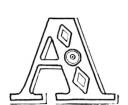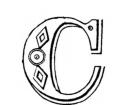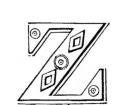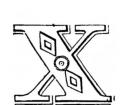 is an Abolitionist—
is an Abolitionist—
A man who wants to free
The wretched slave—and give to all
An equal liberty.
THE ANTI-SLAVERY ALPHABET
Alphabets usually have a not-so-hidden agenda, aiming to do more than reinforce rather arbitrary connections between the names of letters and the words that demonstrate their forms and sounds.
Some alphabets teach the names of animals or common objects. Others just purport to be alphabets but are actually morality tales in 26 brief episodes. This alphabet, published in 1847, was the bright idea of some Philadelphia abolitionists, who wished to remain anonymous. My guess is that it served a triple purpose. In addition to teaching children their ABCs, it taught them – by helping to develop their sense of empathy – that slavery was not nice. And – because parents, grandparents, older siblings, servants, or governesses would likely have read this book over and over again to their little illiterate ones – it might have effectively renewed the same ethical imperative in their own antebellum, bourgeois, callous, enervated, fatigued, and god-fearing souls.
TO OUR LITTLE READERS.
Listen, little children, all,
Listen to our earnest call:
You are very young, ’tis true,
But there’s much that you can do.
Even you can plead with men
That they buy not slaves again,
And that those they have may be
Quickly set at liberty.
They may hearken what you say,
Though from us they turn away.
Sometimes, when from school you walk,
You can with your playmates talk,
Tell them of the slave child’s fate,
Motherless and desolate.
And you can refuse to take
Candy, sweetmeat, pie or cake,
Saying “no”—unless ’tis free—
“The slave shall not work for me.”
Thus, dear little children, each
May some useful lesson teach;
Thus each one may help to free
This fair land from slavery.
Children’s literature didn’t really exist (in the modern sense of “literature”) until the 18th century, and much of that was hardcore moral instruction. Fairy tales were not exactly typical children’s fare, and fantasy in general was considered quite dangerous to young, malleable sensibilities – certainly anything without a vaguely construable Christian moral. The mainstream notion of what constitutes “appropriate” children’s literature has changed quite a bit since then, I would hope. However, a children’s book without a “point” is still a pretty rare bird. Writing such a thing might involve a thorough linguistic and narrative deconstruction: no mean feat, and, considering the still-somewhat-impressionable audience, pretty subversive if you think about it. Now that is a book worth banning!
In any case, there is a universe of forgotten children’s literature to be explored. Thanks to Project Gutenberg for this little foray.
 is the Cotton-field, to which
is the Cotton-field, to which
This injured brother’s driven,
When, as the white-man’s slave, he toils,
From early morn till even.
 is a Zealous man, sincere,
is a Zealous man, sincere,
Faithful, and just, and true;
An earnest pleader for the slave—
Will you not be so too?
 is for Xerxes, famed of yore;
is for Xerxes, famed of yore;
A warrior stern was he
He fought with swords; let truth and love
Our only weapons be. *
*”X” is always a tricky one, isn’t it?
(Posted by Lisa Hirschfield)
